“Don’t **** With Jack Murphy.”
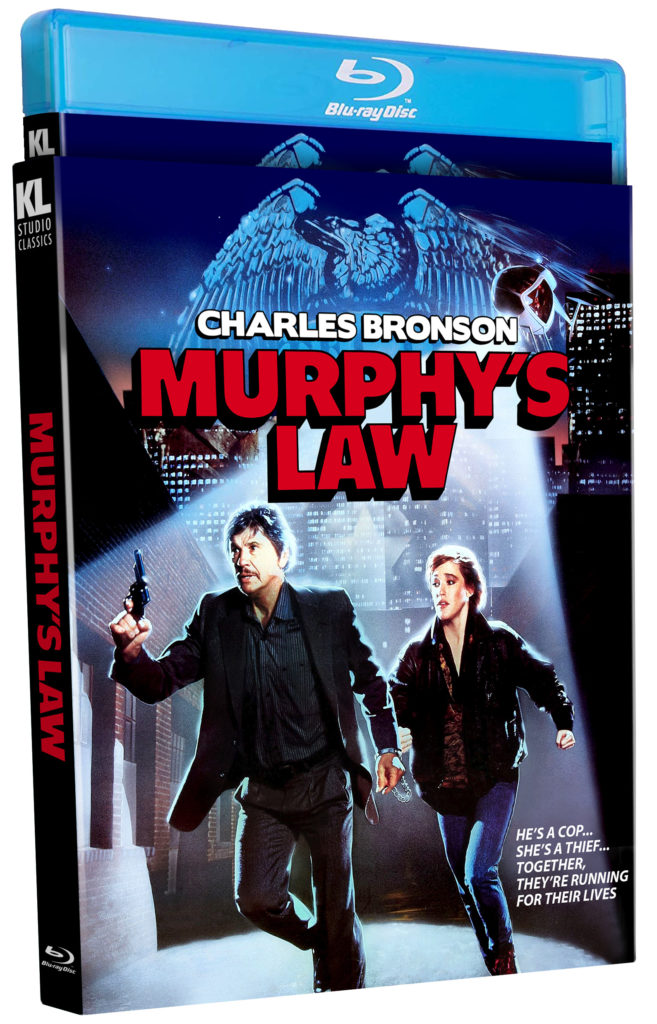
DIRECTED BY J. LEE THOMPSON/1986
STREET DATE: FEBRUARY 15TH, 2022/KINO LORBER STUDIO CLASSICS
“Bronson is back”, as the contemporary radio spots, TV ads, and poster taglines of the day would have it, in Cannon Films’ production of director J. Lee Thompson’s 1986 cop thriller Murphy’s Law, newly released on Blu-ray this mid-February by Kino Lorber Studio Classics.
When last we addressed the all-encompassing subject of Chares Bronson on this site, we left him in the summer of 1974 as Colorado melon farmer Vince Majestyk, having taken on – and defeated – mob hitman Frank Renda (Al Lettieri) and the vast destructive forces of American corruption and capitalistic greed. If the moral of that action-packed saga of self-preservation and fierce independence was unambiguous – ‘Don’t mess with Majestky’s melons’ – twelve years later, during the veteran actor’s 1980’s-filling association with Cannon Films Group, the title-message of 1986’s Murphy’s Law was even more direct, as readers are invited to fill in the unmistakable asterisks covering the relevant word of the bold-type header prefacing this review.
The change, or more accurately the intensification, of Bronson’s screen persona could be attributed to more than merely advancing age – he was, after all, already in his mid-sixties at the time of Murphy’s Law’s release; gamely trying to compete with much younger action pups then nipping at his box-office heels like Sylvester Stallone, Arnold Schwarzenegger, and Cannon’s own other go-to Chuck Norris. In addition to a certain defensive stage in his career, then, this transformation could also be traced back to a singular passage from the actor’s monumental Death Wish (1974), released in American theaters mere weeks after Mr. Majestyk debuted. Mid-Death Wish, following the gang rape-murder of Bronson’s Paul Kersey’s wife and the brutalization of his married daughter, which leaves the latter alive but mute and catatonic, the cultured and left-leaning but slowly unraveling New York City architect Kersey is sent by his firm to negotiate the construction of an ambitious residential housing development potentially rising out of the desert surrounding Tuscon, Arizona.
There, Kersey encounters the eccentric and almost symbolically-named Western real estate tycoon Ames Jainchill (Stuart Margolin), who first takes Kersey to the rifle range – where the citified, Eastern liberal reveals himself as a Korean War conscientious objector who is nevertheless a crack-shot from childhood – and later a night-light glittering Wild West Show, whose unusually lingering effect leaves Kersey in a near-fugue state of resonant indecision.
Arriving back in the city, the spare ghost of the Old West still apparent on his newly vacant, drawn features while he haunts the rooms of his upscale, downtown apartment, Kersey opens a hard-lined box, presented to him by Jainchilll before he departed Tuscon, to reveal a nickel-plated Colt Police Positive with a full-round of ammunition packed tightly beside. The near-fetishistic image, laid across his former marital bed, no less, has obviously overtaken the once light, joking, and smiling Kersey, and the subsequent course of both Bronson’s character and Bronson the actor becomes, in this moment, alarmingly clear.
…
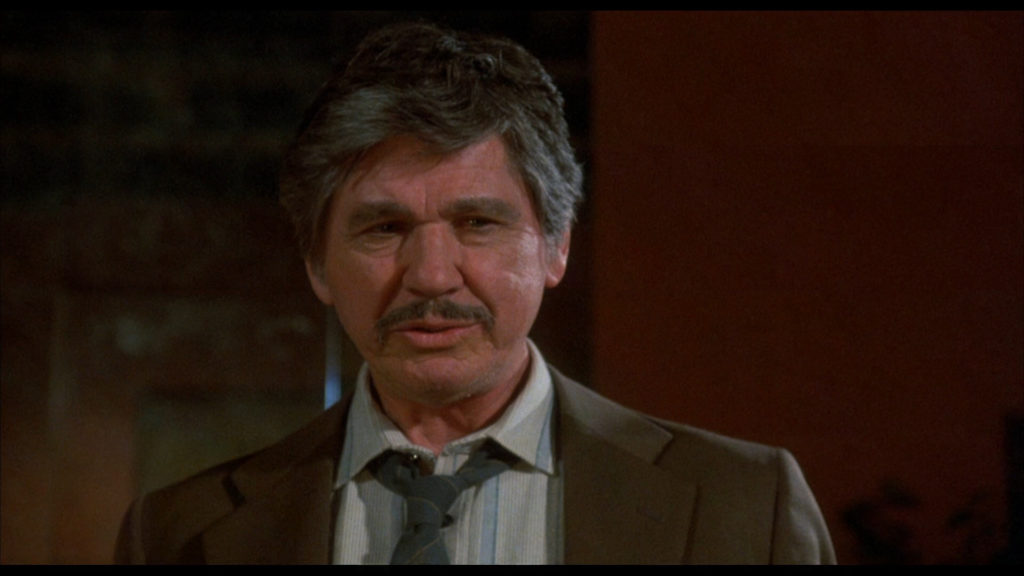
A simplistic reading, true, and the variety of Bronson’s roles before and immediately after, with the Alistair MacLean adventure Breakheart Pass (1975), the lighthearted Western romp From Noon Till Three (1975), the twisty-turny detective parody St. Ives (‘76), and the indescribable Western-horror-adventure hybrid White Buffalo (’77) showing strong if ultimately unprofitable resistance to the Death Wish mold, but with Bronson’s definitive return to the Kersey character eight years later in the even more entrenched, wildly reactionary Death Wish II (1982) – the actor’s first film for Cannon, by the way – Bronson appeared to unequivocally embrace the robotic killing machine that had solidified both the actor’s style as well as the perception of his audience.
Or did he? 1986’s Muphy’s Law in addition to being typical of both the Death Wish sequels and the work of his most frequent directorial collaborator of the period, film veteran J. Lee Thompson – with whom Bronson had made five previous films and would go on to make two more – also evidences a certain odd lightness of touch that adds enjoyable depth and nuance to the expected sleaze-and-gore Cannon so successfully traded on throughout the 1980s. Mid-decade, as well as appearing smack-dab in the center of Bronson’s eight-year association with Cannon Films, Murphy’s Law, viewed in the right frame of mind, shows from sleazy-beginning-to-gory-end just how entertaining the consequences of ****ing with Jack Murphy/Charles Bronson can be.
…
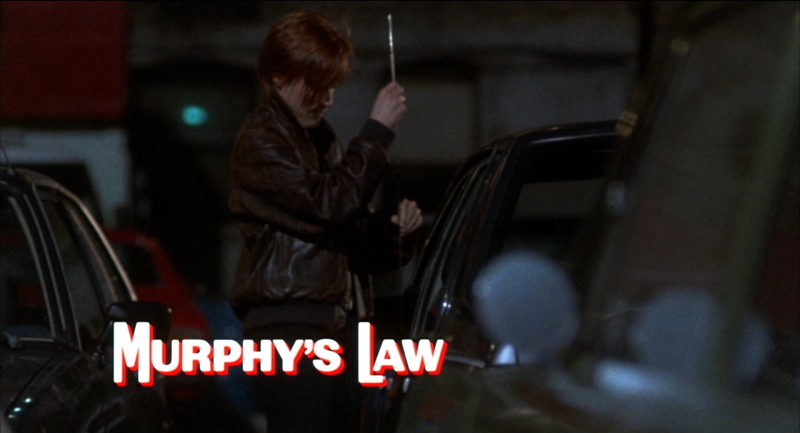
JACK Murphy (Bronson) is a disheveled, alcoholic detective shown effectively foiling the theft of his own car from the neon-lit parking lot of a downtown Los Angeles liquor store in the film’s opening sequence. But, in stopping the car-theft, that Murphy’s grocery bag soon lies trickling booze into the gutter, his snubnose revolver sits emptied of bullets, and his stolen car crashes through a busy storefront’s plate-glass window — its back tires spinning while held aloft by the shattered glass — quickly suggests something to the viewer of this renegade cop’s unconventional (and questionably lawful) M.O. And in soon cornering the foul-mouthed, bright red-mopped young woman who stole his car (Kathleen Wilhoite) – who leads charmingly with such terms of endearment as “snot-rag” and “camel-crotch” – the forceful, resolute officer is also shown equally vulnerable to a good, swift kick to the tenderest part of his otherwise time-hardened anatomy.
MURPHY is next seen investigating the brutal murder of a prostitute beneath a sewer aqueduct graffitied
“Tunnel of Love” with his considerably slicker partner Art Penney (Robert F. Lyons). The course of the investigation leads Murphy to a tense confrontation with the murder’s prime suspect’s older brother, smug mob boss Frank Vincenzo (Richard Romanus), dining with his Old World mother at a fancy Italian restaurant. There, not only do Murphy and Vincenzo exchange their contrasting views on what constitutes “Murphy’s Law” – a phrase whose interpretive double-meaning here indicates both the underlying themes and down-and-dirty aesthetic of 1980’s cop-thrillers – but also gives its possessor (and embodiment) the opportunity to verbally wield a far crasser term directed at the mob boss’s curtain-lace mother – in reference to the old woman’s younger, psychopathic son – for that which was recently kicked below Murphy’s leather belt.
AS the various, seemingly unrelated story-strands weave together in these busy first forty minutes of screen-time – which include Murphy blowing away Vincenzo’s brother through an airport glass window after the latter blows a hole through the head of a stewardess-hostage; soon after re-encountering the punk-girl at another downtown liquor store, this time nimbly side-stepping the crotch-kick and learning her name is, improbably, “Arabella McGee”; and finally mooning about various strip-clubs around town headlined by his ex-wife (Angel Tompkins) – a mysterious middle-aged woman in dark glasses and trench coat (Carrie Snodgrass) is shown gathering information on Murphy after arriving to town by bus. Memorably introduced blowing the head off of an older, bald-domed private eye (Lawrence Tierney), from whom she obtains a detailed portfolio on Murphy, her sharp, blood-splattered features — momentarily flashing through the gaping hole in the PI’s skull — appear to bode ill for our antiheroic good-bad cop.
THESE various plot-points converge past one of Murphy’s final visits to his ex-wife’s performance venue, “Madame Tong’s”, and Murphy’s (stalker-like) tailings to her new boyfriend’s downscale dwelling, the “Tuxedo Terrace Apartments”: where Murphy is knocked-out by the mysterious woman while unlocking his car, and subsequently is made an unconscious, passenger-side accomplice to the drive-by shooting of his ex-wife and her boyfriend.
WAKING up the next morning to his front door being barged into by some of his (many) enemies on the force, Murphy soon stands accused of double-homicide and is roughly, gleefully led by his rivals to his own station in handcuffs, where Murphy finds himself cuffed to none other than the red-headed, trash-talking, car-jacking, crotch-kicking Arabella McGee! Past a few homophobic slurs Murphy and Ms. McGee direct at the male pair of jail-keepers, a dashing escape though the prison corridors up to the roof of the jail – Arabella drag-cuffed in tow – and past a night-flying pursuit over the L.A. skyline in a stolen police helicopter – crashing into the barn of what turns out to be a marijuana farm operated by a quintet of would-be, leather jacket-clad gang rapists – Murphy must put the pieces of these various bizarre events together, put up with the “mouthy broad” tagging along, and finally puzzle out who is behind it all – and most importantly, why – even as the mysterious woman continues to savagely kill various people all over the city directly related to Murphy’s storied past.
CLIMAXING at one of movie-land’s all-time great locations, the Pennsylvania steel-grated, multi-leveled Gothic Art Deco interiors of L.A.’s landmark Bradbury Building, as Carrie Snodgrass’s shotgun-blasting, blood-smearing, sunken tub-drowning, rip cord-strangling, pinpoint crossbow-shooting, and ironically last-named Joan Freeman grasps in her black-gloved, slipping hand the end of an axe, viewers are left to experience the vicarious thrill of its red-handle precariously wedged off an iron railing over a precipitous five-story descent into an elaborately-designed architectural hell…
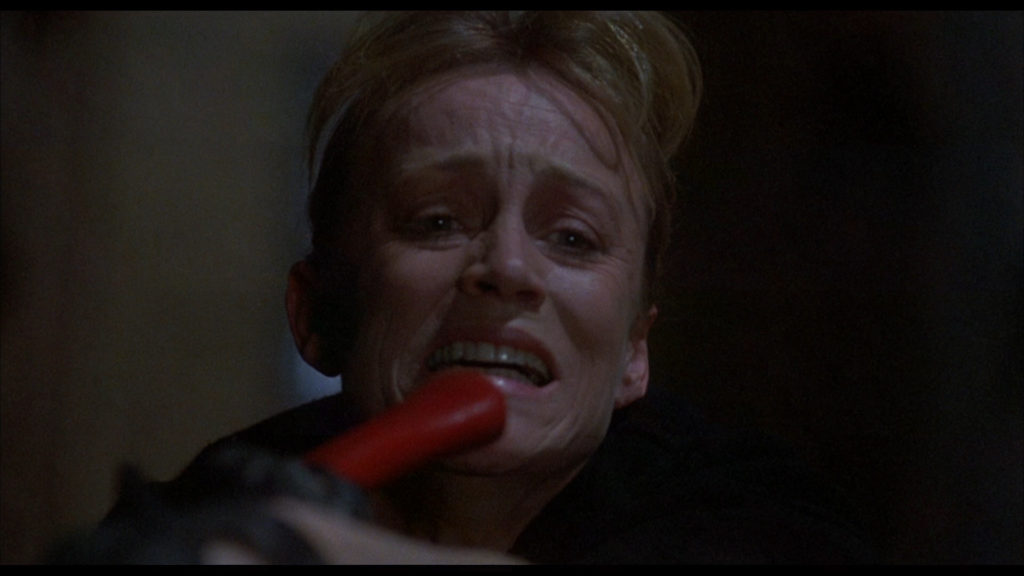
At which point even an over-caffeinated and sleep-deprived reviewer may realize the mounting absurdity of describing in breathless run-on sentences what would be best experienced on the second-bill of a run-down theater in a very bad part of town.
…
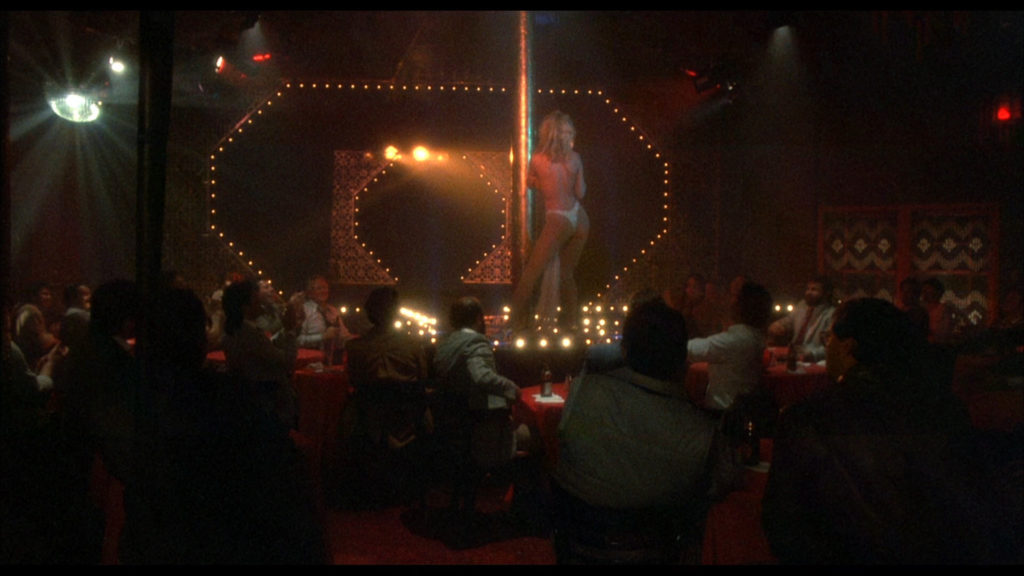
Failing that, Kino Lorber provides a welcome reissue of the now more difficult to find Blu-ray, originally released by the sadly-defunct Twilight Time, and particularly its feature-length commentary/interview conducted by the late Nick Redman with Murphy’s Law’s talented co-star Kathleen Wilhoite. The latter is appropriately a no-holds-barred discussion of an unusually no-holds-barred movie, her account of mid-1980’s young Hollywood excess a suitable accompaniment to the excesses of the mid-1980s proceeding across the screen. Disrobing strippers, gaping gun shot-wounds, bathtub electrocutions, and the phrase “snot-licking donkey fart” all provide effective counter-point to a once promising performer’s account of co-starring in a movie with Charles Bronson at a tender age, carving out a modest acting and singing career throughout the latter half of the 1980s (Wilhoite co-wrote and performed the movie’s title theme, which plays over the end credits), but yet never *quite* achieving the lofty heights to which alleged ex-boyfriends Anthony Edwards or Eric Stoltz ascended. (And actually spending *some* of that time vaguely “on the run” from the silly and stupid mistakes of self-destructive youth; such as, apparently, an impromptu cross-country trip taken to avoid an un-prosecuted DUI!)
Kino Lorber also provides a new, longer interview with frequent Bronson co-star and close friend William F. Lyons, who speaks at length about Charlie’s straightforward process and non-nonsense on-set demeanor. Of particular interest is how the actor, with Bronson, at one point conspired to remove a distasteful element to the script regarding his partner character – a detail which had actually been included, more fittingly, in Bronson’s and Lyon’s much seamier co-starring feature 10 to Midnight (1983), also directed by J. Lee Thompson and produced by Cannon – whose specifics (which one invites viewers/listeners to discover for themselves) should be mainly surprising to those who have seen Murphy’s Law in its entirety, insofar as anyone associated with the production should have exercised any degree of restraint regarding the film’s frankly yet entertainingly outrageous content. (Indeed, “outrageous content” being practically the film’s unusually stubborn raison d’etre.)
As far as Serious Reviewing goes, however, there may be less of immediate, or at least conventional, interest to say about Murphy’s Law, but the 1980’s neo-noir cop-thriller does feature the rare female serial killer among its genre contemporaries, along with many valued, effective views of the era’s invaluable Los Angeles locations. (In addition to the Bradbury Building, the Tuxedo Terrace Apartments, Madame Tong’s, and various era- and regional-specific liquor stores, there’s also Frank Vncenzo’s luxury penthouse lair “El Royale” and yet another sleazy strip-joint simply and memorably called “Affair”.) No, Murphy’s Law will not be docketed for the Criterion Collection anytime soon, but one should be grateful its significance can be nonetheless recognized alongside, say, In the Realm of the Senses (1976), Investigation of a Citizen Above Suspicion (’70), or John Cassavetes’ Love Streams (1984; the last possibly being the sole Cannon Film in the C.C.?) as a deluxe home video release worthy of a slipcover, special features, and an advantageous visual presentation from the best source elements.
And is there in fact a single title from the vaunted Criterion Collection containing the sheer street poetry of a line like, “Blow it out your ***, sperm-count!”? Charles Bronson should have won a freakin’ Academy Award for taking that verbal arrow in stride.
Images in this review are credited to DVDBeaver, but are taken from an earlier Blu-ray release, and are used only as a visual reference to the film, and do not represent Kino Lorber’s Blu-ray.

